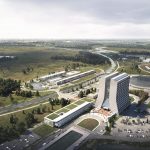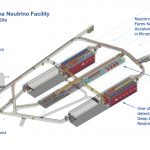LBNF/DUNE/PIP-II/SBN media articles
From Jornal Da Unicamp, Feb. 18, 2021: Fermilab’s Deep Underground Neutrino Experiment is the largest study ever done on the subject in the world and will investigate the structure of the matter and provide answers on important issues related to the formation of the universe. DUNE has the participation of researchers from more than 100 countries, with Brazil as one of the signatories.
From Avvenire, Jan. 19, 2021: Experiments around the world are working to solve mysteries to which neutrinos could hold the answer. Among them is the international Deep Underground Neutrino Experiment, hosted by Fermilab.
From Público, Nov. 24, 2020: Homestake fue la mayor y más profunda mina de oro de de Norteamérica hasta que se cerró en 2002 tras 125 años de funcionamiento. Este remoto lugar de Dakota del Sur se convirtió oficialmente en 2007 en un laboratorio subterráneo de física fundamental, aunque ya mucho antes se habían instalado en sus profundas cavernas algunos experimentos, incluido uno que mereció el premio Nobel. Ahora se anuncia la nueva etapa para convertir la mina en sede del megaproyecto científico más importante de las últimas décadas en Estados Unidos, el Long-Baseline Neutrino Facility, dedicado a estudiar las partículas fundamentales llamadas neutrinos.
From Pesquisa, November 2020: The FAPESP scientific director shares how he encouraged behaviors that helped improve research in São Paulo. With FAPESP encouragement, researchers in Brazil have held leadership positions in international collaborations, including in a photon detection system called Arapuca. Arapuca is a technology used in Fermilab’s Short-Baseline Near Detector and a baseline technology for the international Deep Underground Neutrino Experiment, hosted by Fermilab.
From Black Hills Pioneer, Nov. 17, 2020: Thyssen Mining Company, one of North America’s largest mining companies, has signed a three-year contract to excavate space for the Long Baseline Neutrino Facility at Sanford Lab in South Dakota. The company plans to bring about 110 jobs for miners, operators, mechanics, electricians, engineers, and managers. Thyssen Mining is currently preparing office space in Lead, as well as getting personnel lined up, contracting with local vendors, and preparing equipment for the project.
LBNF/DUNE/PIP-II/SBN Fermilab-produced articles and videos
DUNE’s near detector, located at Fermilab, will take vital measurements of neutrino beam energy and composition before it reaches the experiment’s far detector in South Dakota. Its unmatched precision measurements will offer its own opportunities for the discovery of new physics.
A Fermilab team has completed tests for a crucial superconducting segment for the PIP-II particle accelerator, the future heart of the Fermilab accelerator chain. The segment, called a cryomodule, will be one of many, but this is the first to be fully designed, assembled and tested at Fermilab. It represents a journey of technical challenges and opportunities for innovation in superconducting accelerator technology.
Engineers and technicians in the UK have started production of key piece of equipment for a major international science experiment. The UK government has invested $89 million in the international Deep Underground Neutrino Experiment. As part of the investment, the UK is delivering a series of vital detector components built at the Science and Technology Facilities Council’s Daresbury Laboratory.
A veteran administrator with a love of flowers and true crime, Maxine Hronek draws on three decades of Fermilab experience to keep the international Deep Underground Neutrino Experiment running smoothly behind the scenes — and remind people that science takes the efforts of a whole community of dedicated individuals.
Fermilab scientists and engineers are developing a machine learning platform to help run Fermilab’s accelerator complex alongside a fast-response machine learning application for accelerating particle beams. The programs will work in tandem to boost efficiency and energy conservation in Fermilab accelerators.
The U.S. Department of Energy has formally approved the scope, schedule and cost of the PIP-II project at Fermilab. The PIP-II accelerator will become the heart of Fermilab’s upgraded accelerator complex, delivering more powerful proton beams to the lab’s experiments and enabling deeper probes of the fundamental constituents of the universe.
More than 3,500 researchers from around the world collaborate with Fermilab to develop state-of-the-art technologies and solve the mysteries of matter, energy, space and time. Here is a look at 10 ways Fermilab advanced science and technology in 2020.
What do researchers with the international Deep Underground Neutrino Experiment, hosted by Fermilab, hope to discover? Here’s a hint: DUNE’s science goals have to do with exploding stars, going beyond the Standard Model, and explaining why, exactly, anything exists at all. In this video of an online event hosted by the Sanford Underground Research Facility, DUNE researchers unpack the three major science goals of the experiment.
Results from the ProtoDUNE single-phase detector at CERN pave the way for detectors 20 times larger for the international Deep Underground Neutrino Experiment, hosted by Fermilab.
Contract awarded for the excavation of gigantic caverns for the Deep Underground Neutrino Experiment
This month, Thyssen Mining Inc. was awarded the contract to excavate the gigantic caverns for Fermilab’s Long-Baseline Neutrino Facility. Excavation crews will drill, blast and remove approximately 800,000 tons of rock to create the underground space for LBNF. When complete, the facility will house the enormous particle detector for the international Deep Underground Neutrino Experiment, hosted by Fermilab.
On Oct. 21, the PIP-II Injector Test Facility accelerated proton beam through its superconducting section for the first time. At this test bed for the upcoming PIP-II superconducting accelerator, collaborators will test novel particle accelerator physics concepts and technologies to be deployed in the high-tech front section of PIP-II, the future heart of the laboratory accelerator complex. The milestone achievement also marks the start of a new era at Fermilab of proton beam delivery using superconducting accelerators.
All summer long, progress on preparing the Fermilab site for the construction of the Long-Baseline Neutrino Facility has been proceeding at a healthy clip. Now, as summer winds down, that site prep is nearing completion.
LBNF/DUNE/PIP-II/SBN articles produced by U.S. and international partners
From UKRI, Feb. 22, 2021: UKRI scientists are developing vital software to exploit the large data sets collected by the next-generation experiments in high-energy physics. The new software will have the capability to crunch the masses of data that the LHC at CERN and next-generation neutrino experiments, such as the Fermilab-hosted Deep Underground Neutrino Experiment, will produce this decade.












